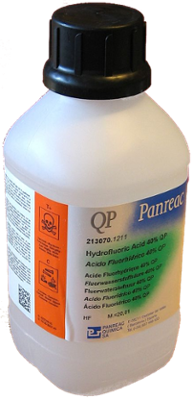Hydrofluoric Acid
 Hydrofluoric acid, hydrogen fluoride in water, has many uses in research laboratories. HF can be used to etch silicon for semiconductor work and can also be used to dissolve rock samples. The use of hydrofluoric acid (HF), at any concentration, requires some unique laboratory preparation and safety precautions. All corrosive material should be handled with care, but HF's high corrosive nature and ability to permeate tissue make it a particular concern. If you intend to use HF in your research please review the information in this section and follow the UC-required SOP as approved by your PI. If there is not an existing HF SOP for your lab that covers your process, please contact EH&S prior to use for assistance in developing a process-specific SOP which is reviewed and approved by your PI.
Hydrofluoric acid, hydrogen fluoride in water, has many uses in research laboratories. HF can be used to etch silicon for semiconductor work and can also be used to dissolve rock samples. The use of hydrofluoric acid (HF), at any concentration, requires some unique laboratory preparation and safety precautions. All corrosive material should be handled with care, but HF's high corrosive nature and ability to permeate tissue make it a particular concern. If you intend to use HF in your research please review the information in this section and follow the UC-required SOP as approved by your PI. If there is not an existing HF SOP for your lab that covers your process, please contact EH&S prior to use for assistance in developing a process-specific SOP which is reviewed and approved by your PI.
Additional HF information can be found on the Calgonate website, http://www.calgonate.com/safety_info.php.
Storage and Safety Concerns
Hydrofluoric acid is corrosive and readily destroys tissue and bone. HF readily penetrates human skin, allowing it to destroy soft tissues underneath and to decalcify bone (hypocalcemea). HF is moderately corrosive to metals and will dissolve glass – hydrofluoric acid must not be stored in glass bottles.
Skin exposure to concentrated HF (49% or greater) immediately results in serious and painful destruction of tissue. One of HF’s most insidious properties is that skin contact at lower concentrations may not produce pain or burning sensations until hours after the exposure. Because of the ability of HF to produce severe delayed tissue damage without producing pain, all skin, eye, or tissue contact with HF should receive immediate first aid and medical evaluation, even if the injury appears minor or no pain is felt.
Inhaling HF vapors can seriously damage the lungs. Delayed reactions up to and including fatal pulmonary edema (flooding of the lungs with body fluids) may not be apparent for hours after the initial exposure. Airborne concentrations of 10 to 15 ppm will irritate the eyes, skin, and respiratory tract. Thirty ppm is considered immediately dangerous to life and health and may have irreversible health effects. At airborne concentrations above 50 ppm, even brief exposure may be fatal. All operations involving HF must be conducted in an exhausting hood.
Any space using HF should be clearly labeled throughout the process. The 'Hydrofluoric Acid In Use' sign should not be removed until work has been completed and the area has been cleaned. Specialty first aid equipment, calcium gluconate (Calgonate®) must be kept on hand and easily accessible. To handle a small spill (<20 mL), calcium carbonate or a commercial, HF specific, spill kit should be kept near HF worksite.
Protective Equipment
Wearing and properly removing Personnel Protective Equipment (PPE) is essential for safely handling HF. Before using PPE always check the condition and functionality (e.g., check gloves for pinholes or for any discolored or brittle sections; chemical splash goggles and face shield for cracks or dirt, coat for holes or tears).
Eye Protection: Work with HF should be conducted with chemical splash goggles not safety glasses; safety glasses do not provide sufficient protection. Use of a full-face shield is recommended, especially when handling high concentrations or volumes.
Skin and Body Protection: An appropriately-sized lab coat must be worn and buttoned to its full length. Laboratory coat sleeves must be of sufficient length to prevent skin exposure while wearing gloves. Full length pants and closed-toe shoes must be worn at all times by the individual conducting the work, and by all others within the laboratory. No portion of the body should be exposed. Coat material should be cotton, polyester or a blend of the two. Nomex coats should not be worn as the acid will penetrate the material.
When handling concentrated HF a vinyl, or other chemical resistant (Tychem), lab apron should be worn over the protection listed.
Glove selection: Concentrated HF - wear heavy (22 mil) nitrile or neoprene gloves when working with concentrated (49%) HF. These gloves should have a long cuff, coming up the forearm. Check chemical compatibility of gloves for other reagents used while handling HF.
Dilute HF - disposable gloves (5 mil) can be used but should be doubled (one size larger over the normal size) when using dilute (<20%) HF. Outer glove can be removed and replaced if incidental contact is detected. After handling HF, remove gloves and wash hands with soap and water.
If direct contact is anticipated, consult with EH&S to identify appropriate protective gloves.
Adding Hydrofluoric Acid to LHAT
The hazard assessment tool does not expressly cover hydrofluoric acid use, only the general use of corrosives. It is UCSC policy to add a custom hazard to the assessment of any lab conducting work with HF. The following information should be added to the "Custom Laboratory Activities" section of LHAT. Note that lab members are still required to take the in person training for HF use.
|
Lab Activity |
Potential Hazards |
Active Researchers PPE |
Adjacent Individuals PPE |
|---|---|---|---|
| Working with dilute HF (<20% hydrofluoric acid) |
|
|
|
| Working with concentrated HF (>20% hydrofluoric acid) |
|
|
|
